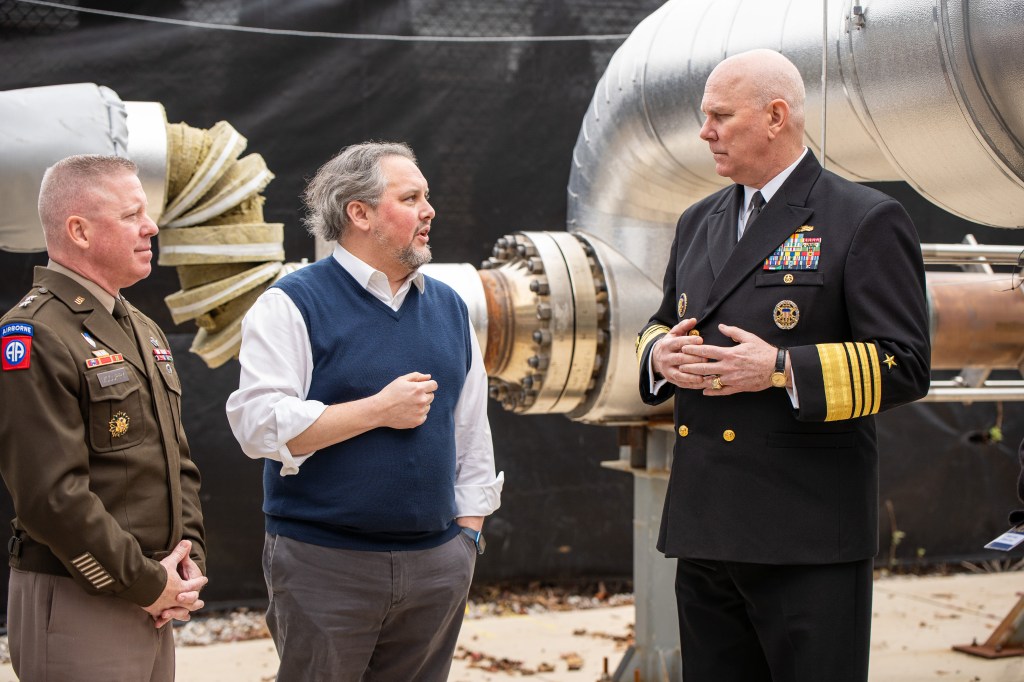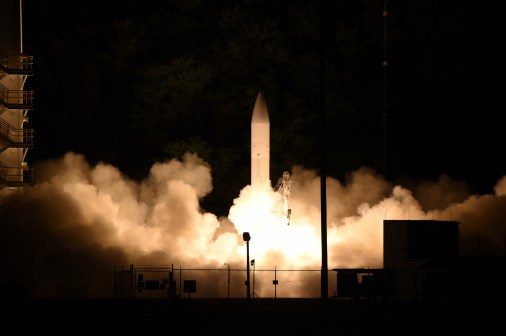Notre Dame opens first-ever Mach 10 quiet wind tunnel for hypersonics testing

SOUTH BEND, Ind. — The University of Notre Dame opened the doors to a new Mach 10 quiet wind tunnel Saturday, a first-of-its-kind facility that adds to the Defense Department’s capacity to research and test hypersonic capabilities.
Hosted by the White Field Research Laboratory, the 3,000-square-foot lab space is home to a quiet wind tunnel able to simulate hypersonic flight at speeds up to Mach 10 — or 10 times the speed of sound. The Navy served as the funding agency for the tunnel’s fabrication, with Naval Surface Warfare Center Crane acting as the contract monitor, and future operations will be funded through research grants and contracts.
DefenseScoop received an exclusive first look at the new facility, which is designed for both fundamental hypersonic research and programmatic testing for the government and industry. The wind tunnel is expected to help the Pentagon address gaps in hypersonics research, testing and workforce development.
“Hypersonic flight represents unique challenges and opportunities, and these facilities are vital to our test and evaluation efforts, enabling us to stipulate and study the extreme conditions that hypersonic vehicles will encounter,” Vice Chairman of the Joint Chiefs of Staff Adm. Christopher Grady said during the ribbon cutting ceremony at the University of Notre Dame.
Hypersonic weapons are maneuvering missiles that fly through the atmosphere at speeds of Mach 5 or higher, making them difficult for adversary air defense systems to intercept them. Their development has been a top priority for the Defense Department in recent years, especially as adversaries like China and Russia continue to tout their own advancements in high-speed missiles.
Although the Army, Navy and Air Force have ongoing programs to develop hypersonic missiles, the department has struggled to get the capability across the finish line — with several programs experiencing problems during their testing campaigns.
“Anything that is testing, anything that is like training ranges and those kinds of things, they often don’t get the heat and light that other things do. But woe be unto us if we don’t invest in those to make sure that we have the apparatus that underpins everything else,” Grady said in an interview with DefenseScoop.
The Pentagon uses wind tunnels to conduct ground testing and validate system performance. The complex facilities are designed to simulate hypersonic flight at austere speeds and atmospheric conditions, giving researchers insights into aerodynamics, thermal management and structural integrity.
But because the few facilities available to the Pentagon are in high demand, the department is turning to Notre Dame and other academic institutions part of the University Consortium for Applied Hypersonics to help close that critical testing gap.
“When we see a university like this or across the entire consortium move into this space, that is really powerful because it adds to that testing ecosystem,” Grady said.
Notre Dame’s new facility is a quiet — or low-disturbance — wind tunnel, meaning it can test hypersonic systems without turbulence, allowing researchers to understand how wind tunnel “noise” impacts performance, Thomas Corke, the university’s Clark Equipment Professor in engineering and director of the university’s Hypersonic Systems Initiative, told DefenseScoop.
“There are some situations in which the impact of the tunnel noise is not important, which then allows the government facilities to continue on that road,” he said. “So it’s very important — and that was in our thinking — to be able to take the same test articles that would be in a government lab … and be able to put the same article in our facility, and be able to make that contrast.”
There are only a handful of quiet wind tunnels in the United States — including a Mach 6 tunnel and a Mach 8 tunnel, both of which are located at Purdue University, and another Mach 6 tunnel operated by Texas A&M University. While Notre Dame’s new facility adds capacity to the hypersonic testing ecosystem, Corke also noted it will be critical to testing at speeds closer to Mach 10 where there are fundamental changes in aerodynamics that occur.
“Ground testing is important, and ground testing is meant to predict what happens in flight. And so if it doesn’t predict what happens in flight, it’s not doing the role it’s supposed to do,” Corke said.

Along with testing capacity, Notre Dame’s new wind tunnel will also address a gap in the workforce that is challenging the United States’ hypersonic systems development by training people who will carry their skills over to government or industry once they graduate.
“The role of a university like this to inflame passions on the part of young scientists and engineers and technicians, I think, is absolutely critical. But then somebody’s got to build this stuff when we finally figure out what the system is,” Grady said. “And so having a strong focus then on — I don’t call them workers, these are craftsmen and artisans of the highest order — is important if it’s going to work.”
Notre Dame is creating a master’s program in hypersonic systems, with a particular focus on developing pipelines from military academies that allow personnel to pursue an advanced degree, Corke said. The university is also training doctoral students on advanced topics related to hypersonics to ensure there isn’t a future gap in people who can teach future generations of engineers and scientists, he added.
The plans align with Grady’s push for workforce “permeability,” a concept he’s working on alongside Deputy Secretary of Defense Kathleen Hicks, he said. The idea is to have people rotate to academia for a few years, and then return to industry or government — where they can receive security clearance — in a continuous cycle.
“We gain because we get all that expertise from academia or industry. I think they gain when they go back, because they understand what we want,” Grady said. “And so that’s the wave of the future in many aspects.”
Updated on Nov. 14, 2024, at 3:15 PM: This story has been updated to note that the wind tunnel is hosted by the White Field Research Laboratory. A previous version stated that it was hosted by the Notre Dame Turbomachinery Laboratory.
Updated on Nov. 18, 2024, at 4:40 PM: This story has been updated to note that Texas A&M University has a quiet wind tunnel.





